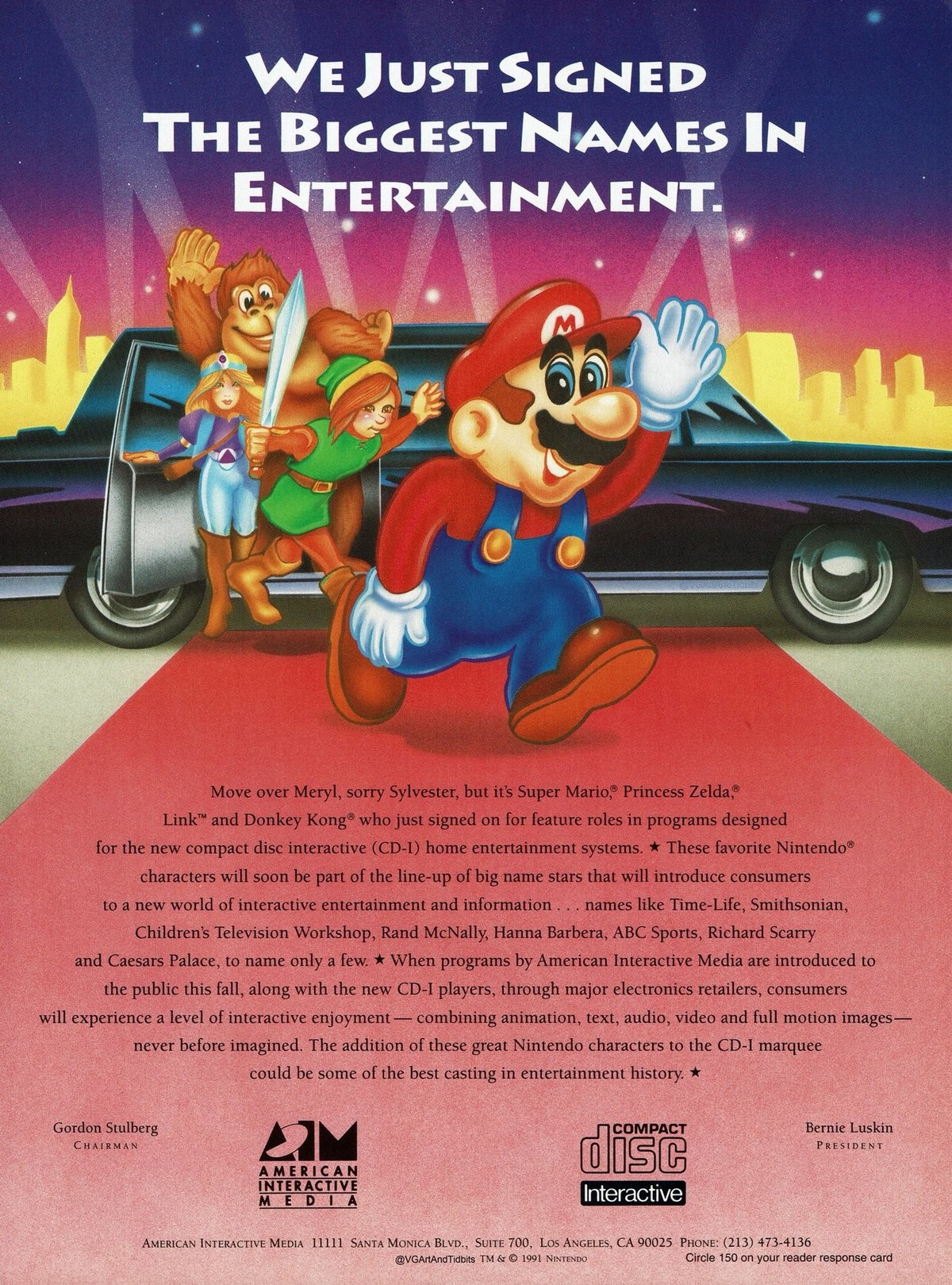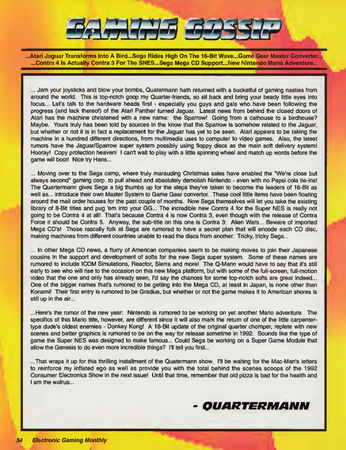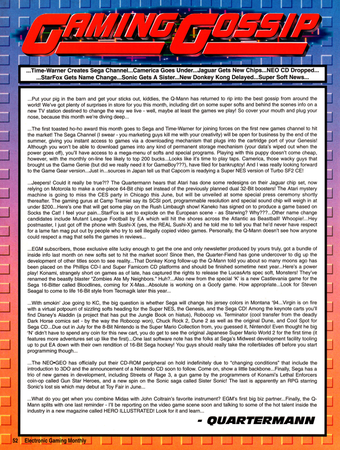Untitled Donkey Kong game (lost builds of cancelled SNES-CD and CD-i platformer; 1992-1993): Difference between revisions
mNo edit summary |
mNo edit summary |
||
| Line 11: | Line 11: | ||
Rumors of the sequel first appeared in the Gaming Gossip section of ''Electronic Gaming Monthly'' issue 31 from February 1992. According to the anonymous writer of the newsletter, Quartermann, the game would be a 16-bit remake of the ''Donkey Kong'' arcade game for the SNES, which would mark Mario's return to his role as the protagonist of the series as well as feature improved graphics and new scenes and would release sometime in 1992.<ref>[https://archive.org/details/Electronic_Gaming_Monthly_Issue_031_February_1992/page/n35/mode/1up ''Electronic Gaming Monthly'' Issue 031 February 1992 page 34 from the Internet Archive.] Retrieved 19 Jan '22</ref> Over one year later in issue 47 from June 1993 Quartermann amended this statement saying the game was a sequel and would release on Nintendo's ill-fated SNES peripheral the SNES-CD as well as the Philips' CD-i.<ref>[https://archive.org/details/electronic-gaming-monthly-issue-47-june-1993/page/n53/mode/1up ''Electronic Gaming Monthly'' Issue 47 June 1993 page 52 from the Internet Archive.] Retrieved 19 Jan '22</ref> | Rumors of the sequel first appeared in the Gaming Gossip section of ''Electronic Gaming Monthly'' issue 31 from February 1992. According to the anonymous writer of the newsletter, Quartermann, the game would be a 16-bit remake of the ''Donkey Kong'' arcade game for the SNES, which would mark Mario's return to his role as the protagonist of the series as well as feature improved graphics and new scenes and would release sometime in 1992.<ref>[https://archive.org/details/Electronic_Gaming_Monthly_Issue_031_February_1992/page/n35/mode/1up ''Electronic Gaming Monthly'' Issue 031 February 1992 page 34 from the Internet Archive.] Retrieved 19 Jan '22</ref> Over one year later in issue 47 from June 1993 Quartermann amended this statement saying the game was a sequel and would release on Nintendo's ill-fated SNES peripheral the SNES-CD as well as the Philips' CD-i.<ref>[https://archive.org/details/electronic-gaming-monthly-issue-47-june-1993/page/n53/mode/1up ''Electronic Gaming Monthly'' Issue 47 June 1993 page 52 from the Internet Archive.] Retrieved 19 Jan '22</ref> | ||
[[File:SNES-CD add-on.jpg|thumb|245x245px|Concept art of the Super Famicom CD-ROM Adapter, the also canceled Japanese version of the SNES-CD.]] | [[File:SNES-CD add-on.jpg|thumb|245x245px|Concept art of the Super Famicom CD-ROM Adapter, the also canceled Japanese version of the SNES-CD.]] | ||
If these rumors are true, the game would likely be developed as two separate versions, one for the SNES-CD and one for the CD-i due to their hardware differences. According to former ''EGM'' editors, Quartermann's newsletter was a mix of legitimate rumors, wishful thinking, and complete fabrications, leaving the validity of these rumors up in the air.<ref>[https://kotaku.com/the-best-video-game-rumors-from-the-early-90s-1699492611 The Best Video Game Rumors From The Early 90s by Patrick Klepek from Kotaku.] Retrieved 19 Jan '22</ref> Lending credence to the game's existence, however, is a LinkedIn profile for one Adrian Jackson-Jones. The profile claims that he worked at RSP as their Super Nintendo and CDI Programmer with one of the games he worked on being Donkey Kong for the CD-i, with him specifically working on designing and implementing the game's engine.<ref>[https://www.linkedin.com/in/adrianjonesgames Adrian Jackson-Jones' LinkedIn page.] Retrieved 19 Jan '22</ref> Donkey Kong also appeared in a CD-i print ad alongside Mario, Link, and Zelda | If these rumors are true, the game would likely be developed as two separate versions, one for the SNES-CD and one for the CD-i due to their hardware differences. According to former ''EGM'' editors, Quartermann's newsletter was a mix of legitimate rumors, wishful thinking, and complete fabrications, leaving the validity of these rumors up in the air.<ref>[https://kotaku.com/the-best-video-game-rumors-from-the-early-90s-1699492611 The Best Video Game Rumors From The Early 90s by Patrick Klepek from Kotaku.] Retrieved 19 Jan '22</ref> Lending credence to the game's existence, however, is a LinkedIn profile for one Adrian Jackson-Jones. The profile claims that he worked at RSP as their Super Nintendo and CDI Programmer with one of the games he worked on being "Donkey Kong for the CD-i", with him specifically working on designing and implementing the game's engine.<ref>[https://www.linkedin.com/in/adrianjonesgames Adrian Jackson-Jones' LinkedIn page.] Retrieved 19 Jan '22</ref> Donkey Kong also appeared in a CD-i print ad alongside Mario, Link, and Zelda despite not appearing in any games released for the console.<ref>[https://imgur.com/a/eRiQ7yf CD-i print ad featuring Mario, Donkey Kong, Link, and Zelda hosted on Imgur.] Retrieved 19 Jan '22</ref> | ||
==Gallery== | ==Gallery== | ||
Revision as of 15:34, 10 May 2022
Published by Nintendo in 1981 Donkey Kong is one of the most iconic video games of all time. It was the first appearance of the company's mascot Mario, launched the long-running Donkey Kong series, and was their first commercial hit in North America, launching Nintendo into the massive video game company they still are today. Due to the iconicity and legacy of the game, it has had three direct sequels over the years, those being Donkey Kong Jr., Donkey Kong III, and Donkey Kong for the Game Boy (alternatively known as Donkey Kong '94). Before the Game Boy games release, there were murmurings of a sequel for the Super NES CD-ROM System and the Philips CD-i.
Background
Rumors of the sequel first appeared in the Gaming Gossip section of Electronic Gaming Monthly issue 31 from February 1992. According to the anonymous writer of the newsletter, Quartermann, the game would be a 16-bit remake of the Donkey Kong arcade game for the SNES, which would mark Mario's return to his role as the protagonist of the series as well as feature improved graphics and new scenes and would release sometime in 1992.[1] Over one year later in issue 47 from June 1993 Quartermann amended this statement saying the game was a sequel and would release on Nintendo's ill-fated SNES peripheral the SNES-CD as well as the Philips' CD-i.[2]
If these rumors are true, the game would likely be developed as two separate versions, one for the SNES-CD and one for the CD-i due to their hardware differences. According to former EGM editors, Quartermann's newsletter was a mix of legitimate rumors, wishful thinking, and complete fabrications, leaving the validity of these rumors up in the air.[3] Lending credence to the game's existence, however, is a LinkedIn profile for one Adrian Jackson-Jones. The profile claims that he worked at RSP as their Super Nintendo and CDI Programmer with one of the games he worked on being "Donkey Kong for the CD-i", with him specifically working on designing and implementing the game's engine.[4] Donkey Kong also appeared in a CD-i print ad alongside Mario, Link, and Zelda despite not appearing in any games released for the console.[5]
Gallery
See Also
- Donkey Kong Country 2: Diddy's Kong Quest (lost build of cancelled Virtual Boy port of Super Nintendo platformer; 1996)
- Donkey Kong no Ongaku Asobi (lost build of cancelled Famicom educational game; 1983)
- Donkey Kong Racing (lost build of cancelled Nintendo GameCube racing game sequel; 2002)
- Donkey Kong: Coconut Crackers (lost build of cancelled Game Boy Advance game; 2002)
- Return of Donkey Kong (lost build of cancelled NES game; existence unconfirmed; 1987-1988)
References
- ↑ Electronic Gaming Monthly Issue 031 February 1992 page 34 from the Internet Archive. Retrieved 19 Jan '22
- ↑ Electronic Gaming Monthly Issue 47 June 1993 page 52 from the Internet Archive. Retrieved 19 Jan '22
- ↑ The Best Video Game Rumors From The Early 90s by Patrick Klepek from Kotaku. Retrieved 19 Jan '22
- ↑ Adrian Jackson-Jones' LinkedIn page. Retrieved 19 Jan '22
- ↑ CD-i print ad featuring Mario, Donkey Kong, Link, and Zelda hosted on Imgur. Retrieved 19 Jan '22




